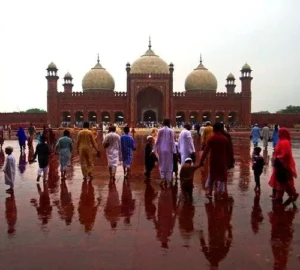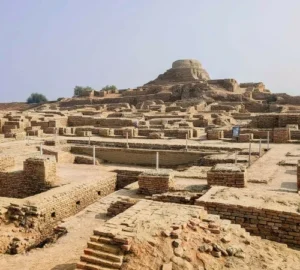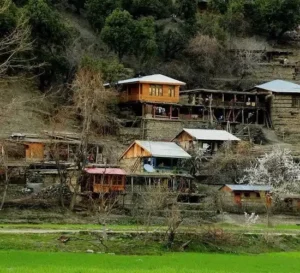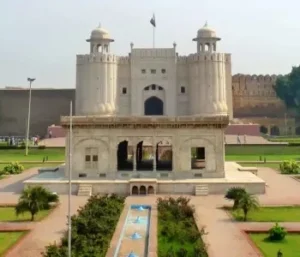Pakistan
UTC+5 (Pakistan Standard Time)
No daylight saving time observed
Pakistani Rupee (PKR)
Symbol: ₨
Coins and notes in various denominations
August 14, 1947 (from British India)
Independence Day celebrated as a national holiday
Ancient civilizations date back to 7000 BCE in the Indus Valley
e-Visa available for many nationalities
Visa on arrival for select countries
Prior approval required for most visitors
Culture
Pakistan's culture is a rich mosaic shaped by its diverse history, geography, and the various civilizations that have flourished in the region over millennia. From the ancient Indus Valley Civilization to Persian, Greek, Central Asian, and British influences, Pakistan's cultural identity reflects its position at the crossroads of South and Central Asia.
Key elements of Pakistani culture include:
- Religious traditions: Islam is the predominant religion, influencing daily life, architecture, art, and social customs. About 96% of Pakistanis are Muslim, with Sunni forming the majority and a significant Shia minority. The country also has small Hindu, Christian, Sikh, Parsi, and Buddhist communities. Religious festivals like Eid-ul-Fitr, Eid-ul-Adha, and Muharram are celebrated with great enthusiasm.
- Linguistic diversity: While Urdu is the national language and English is widely used in government and education, Pakistan has a rich tapestry of regional languages including Punjabi, Sindhi, Pashto, Balochi, Saraiki, and many others. Each language represents distinct cultural traditions and literary heritage.
- Traditional arts and crafts: Pakistan excels in traditional crafts like truck art (decorative painting of vehicles), pottery, woodwork, metalwork, and textiles. The country is renowned for its intricate carpet weaving, particularly in Balochistan and Khyber Pakhtunkhwa, as well as its embroidery styles like Phulkari (Punjab), Sindhi embroidery, and Balochi needlework.
- Architecture: Pakistani architecture spans ancient Buddhist stupas, grand Mughal-era mosques and forts, colonial buildings, and modern structures. Notable examples include the Badshahi Mosque in Lahore, Shah Jahan Mosque in Thatta, and contemporary landmarks like the Faisal Mosque in Islamabad.
- Music and performing arts: Pakistan has diverse musical traditions, from classical forms like Hindustani music to folk styles from each region. Qawwali, a form of Sufi devotional music popularized globally by Nusrat Fateh Ali Khan, is particularly significant. Other important musical forms include Ghazal (poetic expression) and regional folk music like Punjabi Bhangra and Sindhi Sufiana Kalam.
Family is the cornerstone of Pakistani society, with strong emphasis on respect for elders, communal bonds, and traditional values. Extended family networks remain important, though nuclear families are becoming more common in urban areas. Traditional gender roles are still prevalent in many parts of society, though there's significant variation between urban and rural areas and among different socioeconomic groups.
Pakistani cuisine reflects regional diversity and historical influences:
- Punjabi cuisine: Hearty and rich, featuring dishes like butter chicken, sarson ka saag (mustard greens), makki di roti (cornbread), and various kebabs
- Sindhi cuisine: Known for dishes like biryani, sajji (marinated and roasted meat), and the spicy karahi gosht (meat curry)
- Pashtun cuisine: Features chapli kebab (spiced minced meat patties), namkeen gosht (salted meat), and Kabuli pulao (rice dish with meat, carrots, and raisins)
- Balochi cuisine: Known for slow-cooked meat dishes, particularly sajji and kaak (bread similar to a biscuit)
- Kashmiri cuisine: Features dishes like rogan josh (aromatic lamb curry), yakhni (yogurt-based soup), and kahwah (green tea with saffron and spices)
- Street food: Vibrant street food culture with items like golgappay/pani puri, samosas, pakoras, and chaat
Traditional attire in Pakistan includes the shalwar kameez for both men and women, with regional variations in style and embellishment. Women often wear dupattas (long scarves) and men may wear various types of caps or turbans depending on their region and background. In formal settings, men might wear the sherwani (a long coat-like garment), while special occasions for women call for elaborately embroidered outfits and jewelry.
Tourism & Best Sites to Visit
Pakistan offers extraordinary diversity for travelers, from ancient archaeological sites and magnificent mountain landscapes to historic cities and coastal areas. Long overlooked as a tourist destination, it has recently gained recognition from international travel publications as one of the world's most exciting emerging travel destinations.
Here are some of Pakistan's most remarkable destinations:





Hunza Valley: A mountainous valley in the northern Gilgit-Baltistan region, surrounded by several peaks over 7,000 meters, including Rakaposhi and Ultar Sar. Famous for its spectacular scenery, apricot orchards, ancient forts like Baltit and Altit, and the local Burusho people known for their longevity. The turquoise Attabad Lake, formed after a landslide in 2010, has become a major attraction for boating and photography.
Badshahi Mosque: Built in 1671 during the Mughal era, this magnificent mosque in Lahore is one of the city's most iconic landmarks. With its distinctive red sandstone walls, white marble domes, and spacious courtyard that can accommodate 100,000 worshippers, it represents the pinnacle of Mughal architectural achievement and remains one of the largest mosques in the world.
Mohenjo-daro: A UNESCO World Heritage site dating back to 2500 BCE, these archaeological ruins represent one of the world's earliest major urban settlements from the Indus Valley Civilization. The sophisticated city layout, advanced drainage systems, Great Bath, and artifacts discovered here provide fascinating insights into an advanced Bronze Age civilization that flourished well before many other ancient cultures.
Kalash Valleys: Home to the Kalash people, a unique ethnic group with pre-Islamic beliefs and distinctive cultural traditions different from the rest of Pakistan. The three valleys (Bumburet, Rumbur, and Birir) in Chitral district attract visitors interested in their colorful festivals, distinctive dress, and ancient polytheistic traditions that have survived for centuries.
Lahore Fort: A UNESCO World Heritage site adjacent to the Badshahi Mosque, this massive complex was rebuilt in its current form during the Mughal era but has origins dating back more than a thousand years. Its various sections showcase different architectural styles and periods, including the ornate Picture Wall, Sheesh Mahal (Palace of Mirrors), and numerous pavilions and courtyards.
Other remarkable destinations include the breathtaking Karakoram Highway (the highest paved international road, connecting Pakistan to China); the ancient Buddhist ruins at Taxila; the coastal areas of Gwadar and Karachi; the pristine Fairy Meadows with views of Nanga Parbat (the world's ninth-highest mountain); and the Deosai National Park, one of the world's highest plateaus known as the "Land of Giants."
Transportation
Pakistan offers various transportation options, from modern highways and railways to domestic flights connecting major cities. The quality and availability of different modes vary significantly between urban and rural areas, and between different regions of the country.
- Domestic flights: Pakistan International Airlines (PIA) and private carriers like Airblue and SereneAir operate domestic flights connecting major cities including Islamabad, Karachi, Lahore, Peshawar, Quetta, and Multan. Flying is the fastest way to cover the country's vast distances, particularly when traveling between northern mountain regions and southern coastal areas.
- Railways: Pakistan Railways operates extensive networks across the country, though service quality can be variable. The Main Line 1 (ML-1) connects Karachi in the south with Peshawar in the northwest, passing through major cities like Lahore and Rawalpindi. Train classes range from economy to air-conditioned sleepers, with some premium services like the Karachi-Lahore Green Line Express offering comfortable long-distance travel.
- Buses and coaches: An extensive network of intercity buses provides affordable transportation throughout Pakistan. Premium services like Daewoo Express, Faisal Movers, and Skyways offer air-conditioned coaches with comfortable seating on major routes. Local and regional buses serve smaller towns and rural areas, though comfort levels vary significantly.
-
Urban transportation: Major cities have various public transport options:
- Lahore has a modern metro bus system and Orange Line metro train
- Islamabad/Rawalpindi offers the Metro Bus Service
- Karachi has various bus services and minibuses
- Ride-hailing services like Careem and Uber operate in major cities
- Auto-rickshaws and taxis are ubiquitous in urban areas
- Mountain transportation: Northern areas like Gilgit-Baltistan and Khyber Pakhtunkhwa often rely on jeeps for reaching remote mountainous destinations where regular vehicles cannot navigate the terrain. These jeep services are crucial for tourism in areas like Hunza, Skardu, and the Kaghan Valley.
Karakoram Highway: Known as the "Eighth Wonder of the World," this engineering marvel connects Pakistan to China through some of the world's most challenging mountain terrain. It begins in Hasan Abdal near Islamabad and travels through spectacular landscapes to the Khunjerab Pass (the highest paved international border crossing at 4,693 meters), continuing into China's Xinjiang region.
Transportation tips: Consider these factors when planning travel in Pakistan:
- Book domestic flights and premium train/bus services in advance, especially during peak tourist seasons and holidays
- Allow extra time for journeys, as schedules can be affected by weather, particularly in mountainous regions during winter
- For mountain areas, check road conditions in advance as landslides and weather can cause closures, especially during monsoon season
- In major cities, traffic congestion can significantly extend travel times, particularly during rush hours
- For remote areas, consider hiring a local driver familiar with the terrain and conditions
Safety considerations: While transportation infrastructure has improved significantly in recent years, safety standards can vary. Choose reputable operators for long-distance travel, particularly for bus journeys in mountainous regions. Night travel on highways should be approached with caution, especially in remote areas.
Airports
Pakistan has a network of international and domestic airports serving its major cities and regions. The aviation sector has seen significant development in recent years, with several airports being upgraded to international standards.
- Jinnah International Airport, Karachi (KHI): Pakistan's busiest airport serves the largest city and commercial hub. Located about 20 km east of downtown Karachi, it handles the majority of international traffic and serves as the main hub for Pakistan International Airlines. The airport offers connections to destinations throughout the Middle East, Asia, Europe, and North America.
- Allama Iqbal International Airport, Lahore (LHE): Serving Punjab's capital and cultural center, this modern facility has been significantly expanded in recent years. It offers numerous international connections, particularly to the Middle East and Southeast Asia, and is a hub for domestic routes. The airport is located about 15 km from central Lahore.
- Islamabad International Airport (ISB): Opened in 2018 to replace the older Benazir Bhutto International Airport, this state-of-the-art facility serves the capital region. Located about 30 km from central Islamabad, it features modern amenities, expanded capacity, and improved international connections. The Y-shaped terminal building can handle over 9 million passengers annually.
- Bacha Khan International Airport, Peshawar (PEW): Serving the capital of Khyber Pakhtunkhwa province near the Afghan border, this airport offers international flights primarily to Middle Eastern destinations and serves as an important gateway for the Afghan Transit Trade.
- Multan International Airport (MUX): A modernized facility serving the historic city of Multan in southern Punjab, offering international connections primarily to Gulf countries.
- Quetta International Airport (UET): Serving the capital of Balochistan province, this airport handles both domestic and limited international traffic.
- Skardu Airport (KDU): Though primarily domestic, this high-altitude airport in Gilgit-Baltistan is noteworthy for its spectacular mountain setting and its role as the gateway to Pakistan's northern mountain regions, including K2 and other major peaks.
Airport Transportation: Options for reaching your destination from major airports include:
- Taxis: Available at all airports, often with pre-paid counters to avoid fare negotiations. App-based services like Careem and Uber operate at major airports.
- Airport shuttles: Some hotels offer pickup services, particularly in major cities. These should be arranged in advance.
- Car rentals: Available at international airports, though most foreign visitors prefer hiring a car with driver due to challenging driving conditions.
- Public transportation: Limited from airports, though Lahore and Islamabad have some bus connections to their respective city centers.
Important notes: Security procedures at Pakistani airports are stringent. International travelers should arrive at least 3 hours before international flights and 2 hours before domestic flights. Foreign nationals should ensure their travel documents are in order, as immigration checks can be thorough. Photography restrictions apply in and around airports for security reasons.
Visa & Travel Information
Pakistan has made significant efforts to improve its visa policy in recent years, introducing an e-Visa system and visa-on-arrival facilities for certain nationalities to promote tourism. However, most visitors still require advance visa approval.
Visa Types and Requirements
The following table outlines the main visa options for visitors to Pakistan:
| Nationality | Visa Options | Duration |
|---|---|---|
| Most Western Countries (USA, UK, EU, etc.) | e-Visa Available | Tourist e-Visa: 3 months (single or multiple entry) |
| Selected Countries (incl. China, Malaysia, Turkey, UAE) | Visa on Arrival | 30 days (for tourism or business purposes) |
| Citizens of 175+ countries | e-Visa Available | Varies by visa type (tourist, business, etc.) |
| Organized Tour Groups | Group Tourist Visa | 30 days |
| Special Cases (Indian nationals, etc.) | Special Visa Procedures | Varies; often requires additional approvals |
e-Visa Process: Pakistan's online visa system has streamlined the application process for eligible nationalities. The typical procedure involves:
- Creating an account on the official Pakistan Online Visa System
- Completing the application form with personal and travel details
- Uploading required documents (passport copy, photo, travel itinerary, hotel bookings)
- Paying the visa fee online (fees vary by nationality and visa type)
- Receiving visa approval electronically, typically within 7-10 business days
Embassy/Consulate Applications: For those ineligible for e-Visas or requiring specialized visa types, applications must be submitted at Pakistani diplomatic missions. Processing times and requirements vary by location.
Important Travel Considerations
- Registration: Foreign nationals staying in Pakistan for longer than one month must register with the local police or Foreign Registration Office.
- Restricted areas: Some regions require special permits for foreign visitors, including certain parts of Balochistan, Khyber Pakhtunkhwa, and areas along international borders. Check current requirements when planning your itinerary.
- Health precautions: Consider vaccinations for hepatitis A and B, typhoid, and tetanus. Malaria prophylaxis may be recommended for certain regions, particularly during monsoon season. Major cities have good healthcare facilities, but travel insurance with evacuation coverage is strongly recommended.
- Cultural sensitivity: Pakistan is a conservative Islamic society. Dress modestly, particularly in rural areas and religious sites. Women should cover their heads when visiting mosques or conservative areas. During Ramadan, avoid eating, drinking, or smoking in public during daylight hours.
Best time to visit: Pakistan's climate varies dramatically by region:
- October to March: Ideal for southern regions like Sindh and Punjab, with mild, pleasant weather
- April to September: Best for northern mountain areas like Gilgit-Baltistan and Khyber Pakhtunkhwa when passes are open and weather permits trekking
- June to August: Monsoon season affects much of the country, particularly the south, with heavy rainfall; best avoided for most tourism
- December to February: Winter brings heavy snow to northern areas, closing many mountain passes but creating opportunities for winter sports in places like Malam Jabba and Naltar
Communication: Getting a local SIM card is recommended for staying connected in Pakistan. Major providers include Jazz, Telenor, and Zong, available at airports and telecommunications stores with passport registration. 4G coverage is good in urban areas but can be limited in remote regions. Internet cafes are available in cities, and most hotels and many restaurants offer Wi-Fi.
Safety: The security situation in Pakistan has improved significantly in recent years, but travelers should remain vigilant, follow local advice, register with their embassy, and stay informed about regional conditions. Many visitors choose to travel with local guides, particularly in remote areas, both for cultural insights and practical assistance.